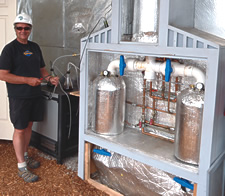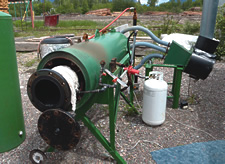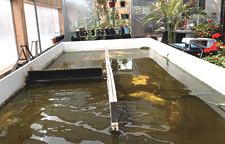 BioCycle July 2011, Vol. 52, No. 7, p. 40
BioCycle July 2011, Vol. 52, No. 7, p. 40
Closed loop system utilizes gasification, algae ponds and anaerobic digestion to convert wood waste to a variety of products, including biofuel, biogas and a soil amendment.
Joan Melcher
MICHAEL Smith is supervising the first commercial-scale Green Power House at the F.H. Stoltze Land and Lumber Co. near Columbia Falls, Montana. Smith, a physicist, has designed a system to take waste products and turn them into a high nitrogen soil amendments while producing energy. The process he’s arrived at, dubbed Algae Aqua Culture Technology (AACT), is at once practical and ingenious, with inputs and outputs interweaving in a closed loop system.
A tour of the pilot-scale greenhouse at the F.H. Stoltze Mill where Smith developed the system begins outside with what he terms the Organic Carbon Engine (OCE). The OCE takes waste wood from the mill and uses a gasification process to create biochar, a bio-oil, carbon dioxide and nitrous oxide to fuel algae growth, and thermal heat to keep other components of the system at desired temperatures. “The OCE does pyrolysis [decomposition brought about by high temperatures], but it is our proprietary version of a gasifier, since it requires balancing the CO2 and heat with the algal production and the energy needed to accelerate the conversion of algae in our anaerobic bioreactors (ABRs),” explains Smith.

What he terms the “Adaptive Behavioral Control System” requires intensive temperature and energy management. It’s a computer-controlled gasification process, with methane used to start the process and added as needed to keep the OCE at temperatures required to produce thermal heat for the system inside the greenhouse. “Once pyrolysis is going, a portion of the energy produced is used to keep the process running,” says Smith. “Methane is sometimes used to supplement the energy consumed by the OCE, but otherwise the methane and bio-oils are used for power generation.”
A local strain of algae is grown in photo-bioreactors (PBR) inside the greenhouse, controlled by a computer-written code that balances sunlight, CO2 and heat to keep the tank at optimum growing conditions. The harvested sludge from the algae tank is directed to a proprietary four-part anaerobic bioreactor (ABR) that produces methane. The digested algae sludge is then mixed with biochar to produce a high nitrogen, water-absorbing organic soil amendment. Methane from the ABR can be used to power a generator. “It’s a completely integrated system that uses waste from one part as the input to another,” Smith said during a site visit. “We figure the algae is doing a lot more than fixing CO2 and converting it into oils. It’s fixing nitrogen and converting it into something we can use. We’re trying to get as many by-products out of the process as we can.”

COMMERCIAL SCALE
Smith will see his work magnified by 64 times with completion of a 5,000-square-foot Green Power House at the F.H. Stoltze Land and Lumber Co. this fall. The state of Montana awarded the project $350,000 in American Recovery and Reinvestment Act funds, and Smith has secured funding from angel investors to complete the total cost of building the system – about $1 million.
The commercial-scale Power House resembles a modern tepee or yurt, with eight pie-shaped sections for algal tanks meeting in center control stations. Pull-down platforms will hold plants on a second level. Plant cultivation was added to the system when Smith realized that algae grow best with mottled sunlight, which the plants will provide. Half the circular building will be made of a triple-ply polycarbonate and the other half will be insulated construction, with a reflexive interior surface.

Three OCEs will be placed outside the greenhouse to thermally power the operation and create biochar. Eight “earth tubes” situated under the algae tanks will pull 55°F air from the ground to maximize heat production in the winter and help with cooling in the summer. Water will be recycled in the system. Smith estimates about 1,000 gallons a week will be needed for the commercial-scale project.
The bio-oil produced by the OCE has a No. 2 Btu rating, adds Smith, and can be cleaned up to burn in a diesel engine. “Or Stoltze can put it in a standard boiler and still meet EPA standards because it’s a renewable resource,” he says. “They can generate power with it as well.” He estimates, based on numbers taken from the pilot project, that the commercial-scale Power House will produce about 2 million Btus an hour from the OCEs.
F.H. Stoltze is a partner in the venture, which -along with generating biofuel, renewable energy credits and power – will serve to utilize tons of wood waste currently being burned in 100-year-old boilers. The commercial Green Power House is designed to produce 2 tons of soil amendment from about 6 tons of wood waste daily. Supply is not likely to be a problem. The mill alone has access to at least 54 tons/day of hog fuel.
A 70-year-old timber industry stalwart in Montana, F.H. Stoltze produces 65 to 70 million board feet of lumber annually and has about 120 employees and 38,000 acres of timber land holdings managed under stewardship forestry principles. Paul McKenzie, the F.H. Stoltze lands and resource manager, said the company is waiting to see firm numbers for potential power generation from the Green Power House. It is assessing several factors related to its future needs, including replacing boilers, providing steam for dry kilns and diversif ying its business plan. McKenzie notes that the company is looking at AACT for its potential in providing diversity through biofuel and other energy products, including generating electricity, and potentially including the sale of renewable energy credits.
Smith has a signed agreement with Stoltze to allow him to build five more Power Houses on company property. If all six were up and running, the electricity available would be 5 to 15 megawatts, enough to power the mill with excess left to sell to the grid (although electricity prices are low due to an abundance of hydropower). McKenzie expressed optimism that Smith will indeed be able to build all six Power Houses. “They’ve got a great program model,” he says. “Getting this first one up and operational and getting some firm numbers is critical. That’s where we’re going to get the hard numbers to prove out what we expect to be the case.”
Computer control of the process is key to what will make it work, Smith notes. “You have four system components,” Smith explains. “Each can be used alone or in concert with each other. Each has a certain amount of intelligence. There’s a handshake between them – it’s what you might call the USB of alternative energy. It’s that level of technology on an industrial scale.” For instance, the computer program for the photo bioreactors can see cold weather coming and begin to adjust to keep the algae tanks at optimum temperatures. The end result is that an operator without a lot of experience can run the system.
MOBILE PROCESSING
Brian Spangler, business development program manager for Montana’s Department of Environmental Quality, is working with Smith to develop a business plan for AACT. He notes that managers of other lumber mill projects in Montana, funded with a $5.3 million grant to create energy from wood waste, are considering the AACT system; one application might be developing a portable OCE that could be mounted on a flatbed trailer and taken into the forest to gasify beetle-killed wood at the source. Smith says if that were done, biofuel from the OCE could power a wood chipping machine and the biochar could be collected and transported for use in a Green Power House, at about a third of the weight of wood waste.
A recent study by Northwestern Energy, a utility serving western Montana, found there’s a plentiful supply of waste wood in Montana – about three centuries worth – of beetle-killed and other waste wood for use in Montana’s seven sawmills if each sawmill used 500,000 bone-dry tons a year.
Joan Melcher, a freelance journalist living in Missoula, Montana, is a contributor to Miller-McCune.com and Planet-Profit Report. Recent stories also have appeared in Via magazine and High Country News.
July 18, 2011 | General










